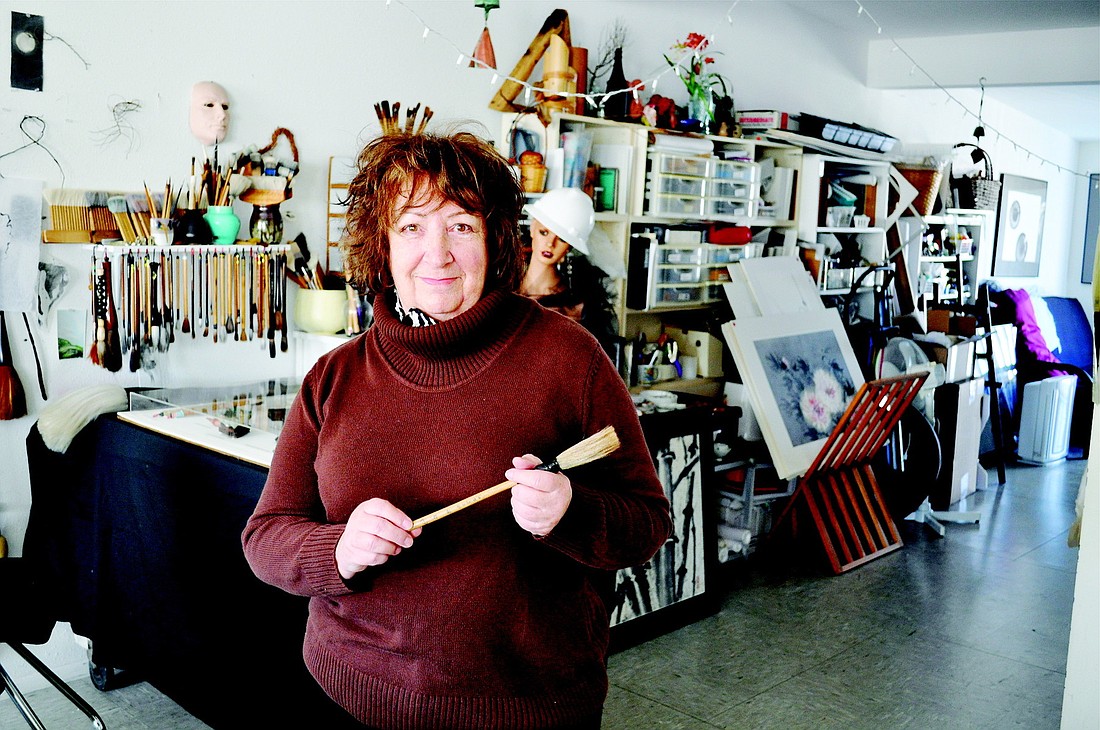- April 19, 2024
-
-
Loading

Loading

Pamela Sumner’s studio is a hidden jewel, the kind of live/work space for which most artists yearn.
Once upon a time, it was located off the beaten path, above a storage company on Sixth Street in a fringe neighborhood in downtown Sarasota called the Rosemary District.
When Sumner moved into the apartment 16 years ago, the Rosemary District wasn’t the up-and-coming hipster hangout it is today. It was where you accidentally ended up if you got lost driving into downtown.
It was seedy. In other words, the perfect place for a budding artist studying Zen Buddhism to grow comfortable in her own skin.
“It was so uncool that I thought it was cool,” Sumner says of the space, which is divided into two halves: a 1,000-square-foot studio drenched with natural sunlight and an apartment that’s nearly as big.
Sumner herself is a hidden jewel. She’s the portrait of calm as she shuffles between her apartment and her studio, cupping a mug of green tea, the smell of which trails her as she speaks softy about her work above the sounds of Japanese flute music.
Her walls are covered in paintings of bamboo, water-based monotypes and images of circular symbols painted on layered panels of spun-bound fabric, which hang like ethereal curtains in her living room.
“I like the way they move and breathe,” Sumner says of the pieces. “They’re done less to repeat the image and more to repeat the body language. I like to get up real close to them. It’s like looking into a pool or someone’s eye.”
The sweeping circular marks found in much of Sumner’s work are referred to as EnsÅ in Japanese culture. In Zen Buddhism the symbols represent enlightenment, the continuum, the void and the theme that most closely resembles Sumner’s life: the expression of the moment.
Sumner is so mindful of the moment that when she teaches private lessons she often blindfolds her students or asks that they paint with their non-dominant hand.
“Anything to shut down the brain and trust the body,” the artist says. “I think everyone has that inherent sense of design and balance, but they tend to over-think it and control it. It was exciting when I learned I could teach people not to be cerebral.”
Sumner grew up in Massachusetts, the daughter of an artist-mother and photographer-father.
Evidence of her parents’ influence is peppered throughout her apartment.
In one bedroom, the floor is collaged with black-and-white photos Sumner’s father took of her as a baby eating creamed spinach. In the kitchen, above the refrigerator, is a portrait of her mother by a famous painter who had a studio near the family’s summer home in Provincetown, Mass.
The painting resembles a pinup poster from the 1950s, and as Sumner passes it, she comments on her mother’s beauty and mentions that the two of them lived together in this space until her mother’s death 13 years ago.
She pulls up a seat at a table in her studio and plucks a pretzel out of a tiny dish.
“I got in a horrendous car crash before I moved to Sarasota,” she says, offering insight into her serenity. “I was working at a design and marketing firm, in Los Angeles. It was the kind of accident that forces you to re-evaluate your life.”
She runs a finger along her left arm, from her shoulder to her elbow, where doctors inserted a steel rod.
Sumner moved to Sarasota shortly after the accident. At the urging of a friend, she enrolled in Chinese painting classes.
“I became obsessed with it,” Sumner says. “I loved the smell of the paint. I loved the brushes. I began painting 40 to 50 hours a week. I didn’t know where I was going with it, but I knew I loved the materials.”
She began hand-grinding her own ink, not because she didn’t want to purchase it, but because she relished the preparation process. It became a pre-painting meditation, a ritual rooted in ancient traditions and techniques.
Six months into studying Asian ink painting, Sumner’s work was accepted into a national exhibition. A year later, she landed a gig creating paintings for cruise ship auctions. In three years she churned out more than 2,000 works.
Sumner began teaching private lessons in her studio and leading workshops at retreats all over the country, which she still does to this day. Her students range from surgeons to priests, musicians to massage therapists, CEOs to athletes.
“The common denominator,” Sumner says, “is that they all want to get out of their heads. They’re all looking for balance. My job is to teach them that the real work is in the process and learning to operate in the present.”
Did you know?
When Whole Foods broke ground in 2004 in downtown Sarasota, Pamela Sumner was asked to curate all the artwork for the project. In the years following, she was commissioned to paint dozens of zen-like pieces for several Whole Foods locations, including the Coral Gables and Palm Beach Gardens stores.
Pamela Sumner’s top five inspirations
• Watching anyone who’s on top of their game: an athlete, a chef, a performer, a poker player. They’re fully focused, in the zone, in the moment. It’s the way I like to paint and what I teach.
• The ancient weathered texture of rocks, the shifting rhythms of the ocean, the flawed perfection of a broken shell.
• Black-and-white photography. Black-and-white TV. Color is so seductive. It tricks the eye and diverts you from seeing the essence.
• The clacking music of bamboo in the wind. When the haunting sounds of shakuhachi (Japanese bamboo flute) fill my studio, it’s time to paint.
• Sharing a vintage bottle of red with friends. Laughter. It’s what balances the solitude necessary to my work as an artist.
Contact Heidi Kurpiela at [email protected]